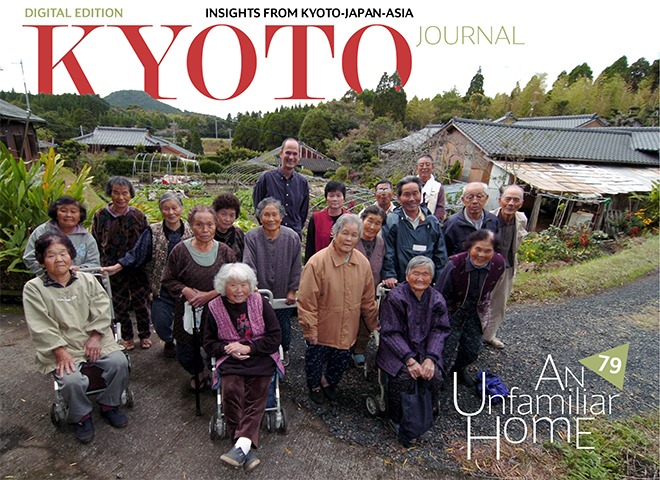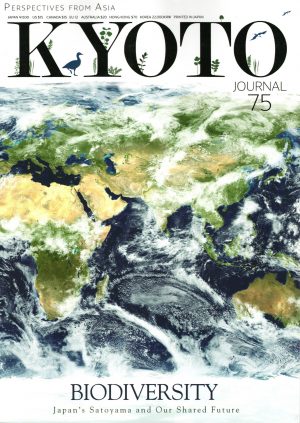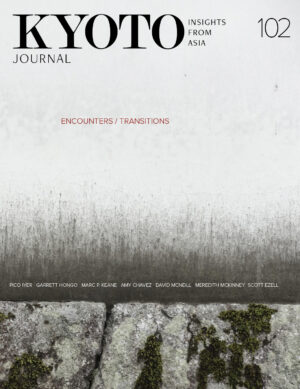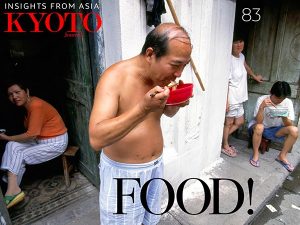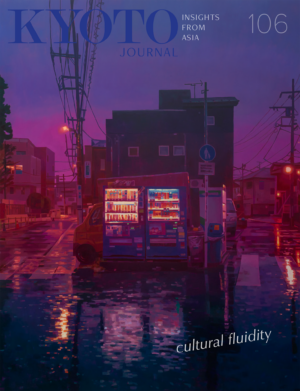Kyoto Journal Digital Issue 79
¥500
(US$4.50)
Bernhard Kellerman's 19th century Japan
The Tohoku Futures Network
The fate of a tiny Kagoshima village
Talking to nuclear refugees
Key Eastern wisdoms teach the inevitability of change.
But when we find ourselves building a new life in new territory—due to an intentional decision or irreversible circumstances—how do we adjust and adapt?
The notion of “an unfamiliar home” of course also applies in many ways to post-3/11 Japan. KJ 79 presents the learning experiences of not only long-term “gaijin” expats making their homes in big-city and rural Japan, but also a wide variety of other people facing life-changing new situations.
AN UNFAMILIAR HOME
Amalia Geibitz meditates on her rainbow-hued life in Dalian, China; Bernhard Kellerman explores the unfamiliar Japan of over a century ago, discovering aspects that are still clearly evident today; Florian Seidel, also from Germany, infiltrates surprisingly recent urban ruins in Kansai. Lora Tomas reconnoiters patriarchal Old Delhi; photographer Daniel Powell captures a self-illuminated modern Japan reminiscent of Taisho-era hand-tinted postcards. Jeffrey Irish describes what he’s learned as head of a tiny Kagoshima village of septuagenarians; Patrick Okafor talks about his life as a Nigerian in Tokyo; Kalsang Dorjee settles into Kansai as a Tibetan political refugee; Prairie Stuart-Wolf interviews mothers living as nuclear refugees in Saga, Kyushu. Winnie Anne Inui closes the communication gap with her bi-cultural son; Jaques Payet arrives to study aikido in Kyoto in 1980, speaking only French— and learns to answer the dojo phone before it rings.
Author Judith Clancy relates the story of her love affair with Kyoto; artist Christine Flint Sato recounts her long engagement with Japanese paper and Chinese ink; and Robert Brady reflects on his relationship with his place in space: Pure Land Mountain. Brendan Joseph Ries discusses spiritual awakening with Acharya Doug Duncan; Jodie Moon meets Kyoto’s “magic mirror” maker. Megumi Nishikura and Lara Perez Takagi talk about their Hafu Project. Roy Hamric rubs shoulders with the ghosts of colonial writers at Chiang Mai’s Gymkhana club, founded in 1868. Victoria Wyatt pens a Canadian zuihitsu on Fukushima, salmon and the fabled Cadborosaurus.
Thai monk Ven. Paisan Visalo draws connections between post-Fukushima Tohoku and his rural temple’s community. Social facilitator Bob Stilger weaves places and people into the Tohoku Futures Network, and Sakaguchi Kyohei, self-proclaimed prime minister of New Japan, outlines his “attitude economy.” Aoki Eiko interviews the curators of “Japan’s Modern Divide,” a LACMA show of photography by Hiroshi Hamaya and Kansuke Yamamoto. In fiction, Kris Kosaka describes an Ainu boy’s first day at school; Rebecca Otowa empathizes with a Shiga villager diagnosed with a fatal condition; Yukiko Tominaga examines survivor’s guilt in a tsunami-stricken wasteland. Poetry takes us to Iraq, Vietnam, and back to Japan, and a suite of intriguingly off-the-beaten-track reviews rounds out the issue.

